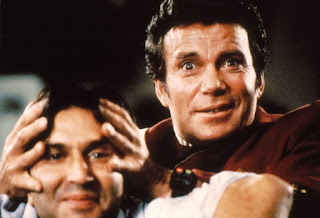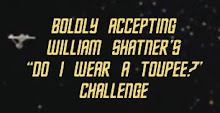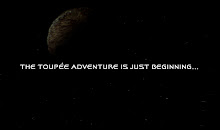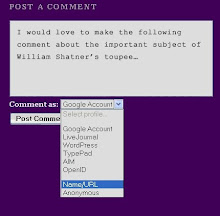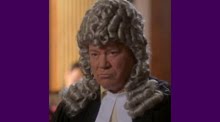
"
Butterflies in Shades of Grey" is a 1994 episode of the revived post-70s run of
Columbo. William Shatner serves as the special guest star, appearing in the series for the second time - the first being in the classic 1976 episode "
Fade in to Murder".

Fielding Chase (William Shatner) is a suave but ruthless right-wing radio talk show host and also the head of a mini L.A-based media empire.

His adopted daughter Victoria (Molly Hagan), of whom Chase is extremely possessive, is an aspiring novelist - though she is keeping those aspirations secret from her father.

Gerry Winters (Jack Laufer), an investigative reporter working for Chase, meets secretly with New York literary agent Lou Cates (Richard Kline), who appears interested in one of Victoria's manuscripts. Winters' motivations in bringing fame to his friend aren't romantic (turns out he's gay), but rather he wants to free Victoria from her father's domination, and in so doing, cause his boss some grief.
The ongoing professional animosity between Chase and Winters explodes after an investigative assignment yields nothing; the boss, certain a potential story was missed, fires his unruly subordinate.

Victoria finally tells Chase her secret - that she has written a novel and that Winters is helping her get it published. Chase pretends to be delighted and offers assistance to his daughter. But in reality, he is deeply perturbed.

Literary agent Cates calls Winters and tells him that his publisher actually ended up hating the manuscript - but that the man is also an acquaintance of Chase's. Coincidence? Could the father have intervened to disrupt his daughter's budding career?

Winters confronts Chase with this accusation. Chase dismisses this as a lie, calling his daughter's ambitions nothing but a "pipe dream". Winters then accuses Chase of having a less than fatherly attitude; Chase slaps and threatens to kill him - in front of witnesses.
Victoria learns what her father did, but he persuades her that his intentions were not to possess her, but rather to help her career.
Meanwhile, Chase devises a plan to kill his nemesis. Arranging for Winters to telephone him at precisely 4pm, Chase's answering machine records the entire murder - a masterful alibi.

Chase is pretending to be at home listening in as gunshots are fired by an unknown assailant. In truth, he is killing Winters himself, while meters away on the other phone in Winters' house.

Chase then plants some evidence framing a former lover of Winters' as the murderer.
Enter Columbo...

That's where we'll leave the plot.
In a break from custom, we'll move straight to the hair next before we review this episode.

Star Trek: Generations
(1994).Considering the excessive thickness on display in
Star Trek: Generations (1994), the TJ Curly seen in this episode (made around the same time) is something of an outlier. It's less dark, less curly, less long, less thick, the hairline less harsh - far more akin to latter stages of the TJ Curly around 1999, when it began to gradually morph into the "Denny Katz" style (more on this gradual morphing in a future post).
The toupee cliché about a dark rug betrayed by greying hair around the sides appears reversed here.

Unusually, here the toupee is actually greyer and lighter than Bill Shatner's real hair at the sides.

Evident in the background in several shots is the notorious "
peeling toupee" photograph.

In this case, it is altered to include a mustache.

But perhaps most fascinating of all is another piece of artificial hair on display - a false mustache.
Not only is the mustache in question occasionally crooked, but it also seems to drastically change color during the episode.
Very light:

Very dark:

The toup too appears to change at times. Sometimes a little longer, sometimes shorter.

And in perhaps the only example of interesting direction in the entire episode, there is a brief shot that appears loaded with subtle toupological symbolism.
 The spikes of hair represented by the glass - Bill Shatner is between these spikes; the real-haired Columbo is behind. Toupological symbolism?
The spikes of hair represented by the glass - Bill Shatner is between these spikes; the real-haired Columbo is behind. Toupological symbolism?So, what to make of the overall episode? The story, though rather convoluted, is not too bad; the murder and Columbo's solving of it is not too bad either. But the whole thing is frankly average at best. Nothing special. Rather unremarkable. Why? Something crucial is missing...
 1970s
1970s Columbo.
Many of us at
WSSTS are unabashed fans of the original 70s
Columbo and regard it, without hesitation, as one of the greatest TV shows of all time. It was intelligent; it was non-violent; it was occasionally funny and it broke many accepted rules. This from a
great article on how the series was formed, written by the series' creators:
Our first scripts made their way to the network, and the response was not effusive: NBC had major "conceptual concerns" with our approach. How could we have made the terrible blunder of keeping our leading man offstage until twenty minutes into the show? Didn't we realize that Peter Falk was our star? The audience would expect to see him at once, and here we were perversely delaying his appearance. One of the executives called it, with considerable heat, "the longest stage wait in television history."There were other complaints. What about this business about an unseen wife? And why a wife at all? Columbo should be free of any marital encumbrances so that he could have romantic interludes on occasion. Why hadn't we given him a traditional "family" of regulars? At the very least he should have a young and appealing cop as his assistant and confidante. And worst of all, the scripts were talkative. They should be enlivened by frequent doses of adrenalin in the form of "jeopardy."There are only four responses a writer-producer can make to network suggestions: He can ignore them, he can cave in, he can argue, or he can threaten to quit. We opted for the last of these multiple choices.
Columbo keeps accidentally annoying an innocent old lady.
The above demonstrates that the fight to make something truly unique was at the heart of
Columbo's greatness. But in addition to all of the above considerations of content, there was also a crucial aesthetic component. The 70s cinematography - sharp and very high-contrast film stock requiring a lot of light, with its very particular color relationships; this, plus the overall 70s aesthetic - the era of orange and yellow seat covers and minty green paint and still clean-looking post-war concrete architecture. That part made the city of Los Angeles itself seem strangely sleek and alluring (deliberately "mythical" according to
Link and Levinson, the series' creators, as noted in the above article).

The airport, the hospital, the store, the chilli stand - Lt. Columbo inhabited a highly stylized and inviting 70s world. Even a trip to the supermarket seemed pretty cool...

There was also the direction - bold and distinct.

Often, murders would be filmed in highly abstract and stylized ways. Add to that the tremendous music (sadly, the series' soundtracks have never been released), full of recurring leitmotifs and diverse and distinctive instruments. Overall,
Columbo's intellectual, wordy drama was balanced out by this aesthetic onslaught. Memorable. Re-watchable. Full of classic moments. Much like the original
Star Trek.
 A chess match with the great Tomlin Dudek brings nightmares.
A chess match with the great Tomlin Dudek brings nightmares.So what if you took away the bold cinematography, direction, music and the overall awesome background of 1970s L.A. in addition to having an unremarkable script? You'd pretty much get "Butterflies in Shades of Grey." Some of the components are still there (though it is hardly believable that the great Columbo would not have been promoted or retired by the 1990s; his old battered car is also arguably a stretch too far), but these other crucial elements are missing.
 Visually dull compared to the original series - "Butterflies in Shades of Grey".
Visually dull compared to the original series - "Butterflies in Shades of Grey". Aesthetically speaking, the late 80s/early 90s were a pretty dire time for American television drama. Soft, pink-hued, red-biased cinematography, coupled with the styles of the times - shoulder pads, bad perms and all the rest of it. The era of lots of bad TV movies with names like
Why Did She Die? The Jennifer O'Brady Story (we made that one up). Sometimes, old-fashioned stylistic boldness was even punished (see our piece on composer
Ron Jones). TV, thankfully, eventually largely recovered from this aesthetic lull, with series like
NYPD Blue and
The X-Files leading the way.
As for the content part (crucial - much 70s TV drama was pretty awful too),
Columbo's drama harked back to the 1940s and its focus on the woes and wants of a post-revolution American aristocracy that had somehow managed to survive into the latter part of the 20th century. And what was Lt. Columbo in all of this? Disheveled, unpretentious, Zen-like - a stark contrast to all of that highly-strung decadence.
 Columbo eats chilli.
Columbo eats chilli.On a more metaphysical level (yikes!!), Columbo perhaps also represented the human conscience itself. The murderers had committed terrible crimes. At that moment Columbo appeared, gnawing away at their repressed and self-destructive guilt - "just one more thing," he'd say, innocently irritating them beyond breaking point.
No matter how perfectly they planned their murders, how much they pretended to actually be helping Columbo find the
real killer, how hard they tried to explain away his endless questions, their lives could never be normal again. And when they finally confessed, very stoically, in most cases their relief was palpable. The conscience, thankfully, won. Often the murderers were even likeable, charming people. Columbo, gallant as ever, would insist to the arresting cops that the handcuffs weren't necessary.
70s
Columbo had endless classic episodes (and only a handful of stinkers): the one with the twin brothers; the Nimoy one with the sutures; the chess one;
Robert Vaughn on the cruise ship;
Jackie Cooper as the senate candidate; the one with the sweet old lady (Ruth Gordon); the one with Ann Baxter as the archetypal diva; three episodes each for arguably the best villains
Jack Cassidy and
Robert Culp; the one where Columbo actually goes after his own boss; the one with
Johnny Cash! The list goes on...

...and certainly includes Bill Shatner's classic role in "Fade in to Murder". But in that role, Shatner's character was tragic and complex, in need of salvation and forgiveness. Much more suited to Bill Shatner's acting and character. In "Butterflies in Shades of Grey" the murderer is really without any redeeming or even interesting qualities, and frankly, so is the episode.
 Bill Shatner in 1976's classic "Fade in to Murder".
Bill Shatner in 1976's classic "Fade in to Murder". Irrespective of the merits of the revived
Columbo (which ran sporadically between 1989-2003 and certainly had some strong episodes), the original series is undoubtedly iconic and was also a comfortable home for many equally iconic stars, including
The Prisoner's Patrick McGoohan. Its star, Peter Falk, with his deep and unerring Leonard Nimoy-like protectiveness about the series' quality, passed away at the end of June after battling for several years with Alzheimer's disease. Falk had a varied career as an actor, but like Bill Shatner's Captain Kirk, he will always be remembered for his most famous role - that of the legendary Lt. Columbo.
 Peter Falk (1927-2011).
Peter Falk (1927-2011).





